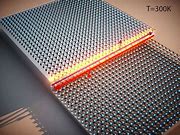The world of quantum physics is a fascinating realm where particles behave in ways that often defy conventional logic. Imagine a school of fish moving in perfect harmony or fireflies lighting up the night sky together – these are examples of collective behavior in nature. Now, picture a similar synchronized dance happening at the quantum level, giving rise to phenomena like superconductivity, superfluidity, and superfluorescence.
Macroscopic quantum phase transitions are key to unlocking these exotic processes. Typically, such transitions require extremely cold conditions to occur because higher temperatures introduce thermal “noise
” that disrupts the synchronization needed for these transformations. However, recent groundbreaking research has shed light on how certain materials can exhibit macroscopic quantum coherence even at ambient temperatures.
In a collaborative effort led by North Carolina State University, researchers from Duke University, Boston University, and the Institut Polytechnique de Paris embarked on a journey to unravel the mysteries behind high-temperature quantum effects. Professor Kenan Gundogdu from NC State explains their findings: “
In this work, we show both experimental and theoretical reasons behind macroscopic quantum coherence at high temperature.
”
Their study focused on hybrid perovskite materials known for their unique atomic structure that shields quantum particles from thermal interference long enough to undergo phase transitions. These materials enable the formation of large polarons – groups of atoms bound to electrons – which play a crucial role in insulating light-emitting dipoles from external disturbances and facilitating superfluorescence.
To delve deeper into this phenomenon, the researchers utilized lasers to excite electrons within the hybrid perovskite material and observed the emergence of solitons – coherent formations of polarons within the atomic lattice. Gundogdu elaborates on this analogy: “
Picture solid balls placed on a fine cloth representing excitons; each ball deforms the cloth locally. For superfluorescence to occur, all excitons need to form a coherent group interacting with the lattice as one unit.
”
Mustafa Türe, an NC State Ph.D. student involved in the study, highlights how soliton formation is contingent upon achieving a critical density of polarons: “
Our theory demonstrates that below a certain threshold density, polarons exist in an uncorrelated phase; however, beyond this threshold, they evolve into solitons.
” This transition from disorder to order is crucial for dampening thermal disturbances that hinder quantum effects.
Melike Biliroglu, postdoctoral researcher at NC State and co-first author of the work emphasizes: “
We directly observed the evolution of polarons from an incoherent state to an ordered phase – marking one of our first glimpses into macroscopic quantum state formation.
” The team’s collaboration with experts like Volker Blum and Vasily Temnov further validated their experimental results through simulations confirming the intrinsic coherence of solitons.
Franky So, Walter and Ida Freeman Distinguished Professor at NC State notes how prior to this research there was limited understanding around high-temperature quantum effects in hybrid perovskites: “
This work provides both quantitative theory and experimental evidence supporting our findings.” Gundogdu underscores the significance by stating: “Macroscopic quantum effects are essential for advancing technologies like quantum communication and computation; our insights offer pathways for designing new high-temperature quantum materials.”
This groundbreaking exploration into solitonic superfluorescence represents a pivotal step towards harnessing exotic quantum states at elevated temperatures. With support from organizations like Department of Energy’s Office of Science (grant no. DE-SC0024396), researchers across multiple institutions have laid down foundational knowledge for future advancements in quantum material design.
Xixi Qin and Uthpala Herath from Duke University along with Anna Swan from Boston University and Antonia Ghita from Institut Polytechnique de Paris played integral roles in this transformative study. Through their collective efforts and interdisciplinary approach, these scientists have opened doors to unprecedented possibilities in high-temperature quantum phenomena.

